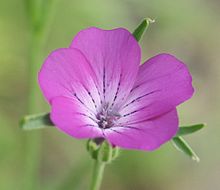
There are at least 177 members of the order Caryophyllales found in Montana. [1] Some of these species are exotics (not native to Montana) [2] and some species have been designated as Species of Concern. [3]

There are at least 177 members of the order Caryophyllales found in Montana. [1] Some of these species are exotics (not native to Montana) [2] and some species have been designated as Species of Concern. [3]
Family: Amaranthaceae

Family: Cactaceae
Family: Molluginaceae
Family: Nyctaginaceae
Family: Sarcobataceae

Family: Caryophyllaceae

Family: Portulacaceae

Caryophyllaceae, commonly called the pink family or carnation family, is a family of flowering plants. It is included in the dicotyledon order Caryophyllales in the APG III system, alongside 33 other families, including Amaranthaceae, Cactaceae, and Polygonaceae. It is a large family, with 81 genera and about 2,625 known species.

Chenopodium is a genus of numerous species of perennial or annual herbaceous flowering plants known as the goosefoot, which occur almost anywhere in the world. It is placed in the family Amaranthaceae in the APG II system; older classification systems, notably the widely used Cronquist system, separate it and its relatives as Chenopodiaceae, but this leaves the rest of the Amaranthaceae polyphyletic. However, among the Amaranthaceae, the genus Chenopodium is the namesake member of the subfamily Chenopodioideae.
There are over 190 vascular plant species on the Norwegian Arctic archipelago of Svalbard. This figure does not include algae, mosses, and lichens, which are non-vascular plants. For an island so far north, this number of species constitutes an astonishing variety of plant life. Because of the harsh climate and the short growing season, all the plants are slow growing. They seldom grow higher than 10 cm (4 in)
This is a list of plants and how they are used in Zuni culture.

The flora of Lebanon includes approximately 2,600 plant species. Situated on the eastern coast of the Mediterranean Basin, Lebanon is a reservoir of plant diversity and one of the world's biodiversity hotspots for conservation priorities. Endemic species constitute 12% of the Lebanese flora; 221 plant species are broad endemics and 90 are narrow endemics. Important Plant Areas (IPAs) featuring the country exceptional botanical richness were defined in 2018.

California is the largest grower of peaches in the United States, producing about 70% of the total.